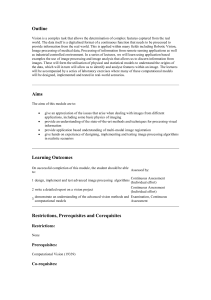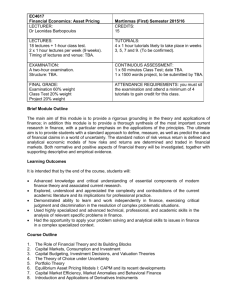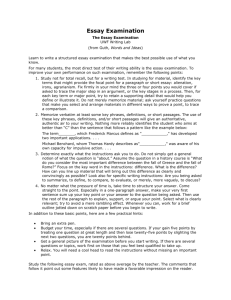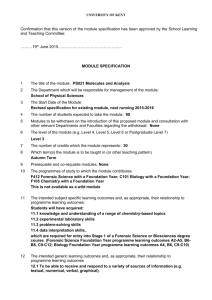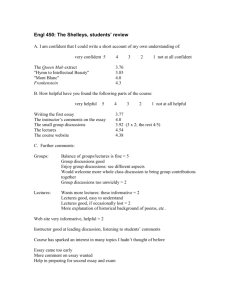MS-Word
advertisement
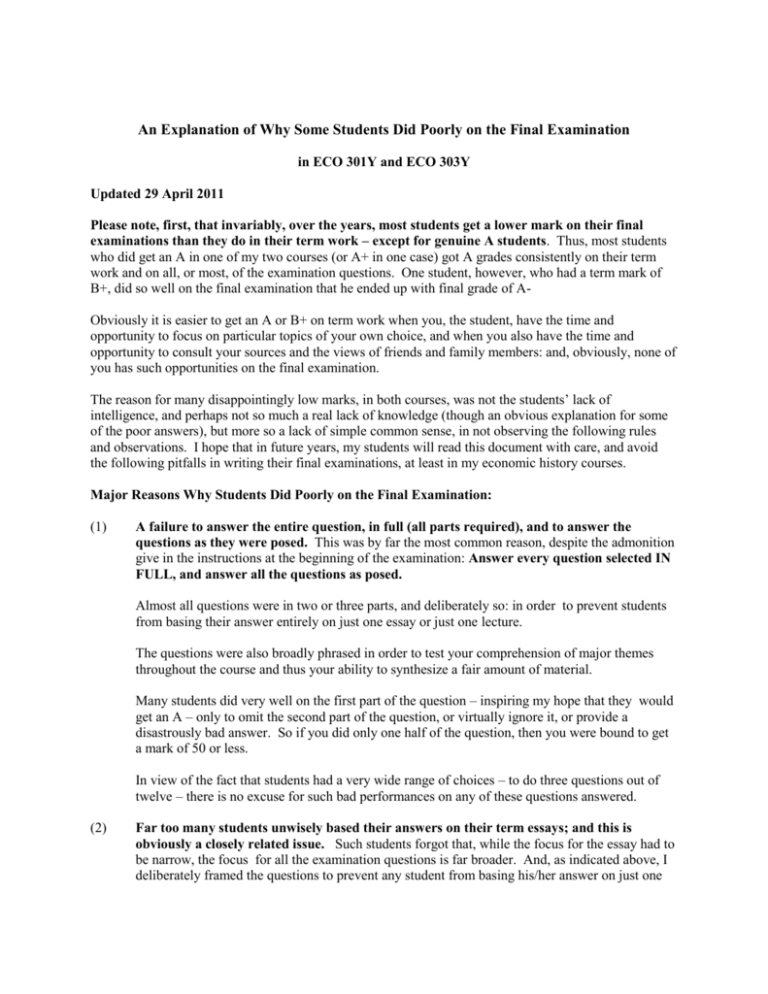
An Explanation of Why Some Students Did Poorly on the Final Examination in ECO 301Y and ECO 303Y Updated 29 April 2011 Please note, first, that invariably, over the years, most students get a lower mark on their final examinations than they do in their term work – except for genuine A students. Thus, most students who did get an A in one of my two courses (or A+ in one case) got A grades consistently on their term work and on all, or most, of the examination questions. One student, however, who had a term mark of B+, did so well on the final examination that he ended up with final grade of AObviously it is easier to get an A or B+ on term work when you, the student, have the time and opportunity to focus on particular topics of your own choice, and when you also have the time and opportunity to consult your sources and the views of friends and family members: and, obviously, none of you has such opportunities on the final examination. The reason for many disappointingly low marks, in both courses, was not the students’ lack of intelligence, and perhaps not so much a real lack of knowledge (though an obvious explanation for some of the poor answers), but more so a lack of simple common sense, in not observing the following rules and observations. I hope that in future years, my students will read this document with care, and avoid the following pitfalls in writing their final examinations, at least in my economic history courses. Major Reasons Why Students Did Poorly on the Final Examination: (1) A failure to answer the entire question, in full (all parts required), and to answer the questions as they were posed. This was by far the most common reason, despite the admonition give in the instructions at the beginning of the examination: Answer every question selected IN FULL, and answer all the questions as posed. Almost all questions were in two or three parts, and deliberately so: in order to prevent students from basing their answer entirely on just one essay or just one lecture. The questions were also broadly phrased in order to test your comprehension of major themes throughout the course and thus your ability to synthesize a fair amount of material. Many students did very well on the first part of the question – inspiring my hope that they would get an A – only to omit the second part of the question, or virtually ignore it, or provide a disastrously bad answer. So if you did only one half of the question, then you were bound to get a mark of 50 or less. In view of the fact that students had a very wide range of choices – to do three questions out of twelve – there is no excuse for such bad performances on any of these questions answered. (2) Far too many students unwisely based their answers on their term essays; and this is obviously a closely related issue. Such students forgot that, while the focus for the essay had to be narrow, the focus for all the examination questions is far broader. And, as indicated above, I deliberately framed the questions to prevent any student from basing his/her answer on just one essay. I had warned the class that, while I am always obligated to included all ten A-list topics on the final examination, I reserve the right to combine two or more such topics; and also to combined such topics with other topics from the lectures. So, while doing an A-list topic should have provided some advantage – in that doing the research (going from the general to the particular) for the essay helped the student prepare for the final examination, no students could expect to base any examination questions solely on one A-list topic essay. Many such students also thought that, because they had received a good grade on their essay, they actually understood the topic well, when in fact they did not – of failed to reveal that on their examination answers. Thus many of these students who virtually regurgitated their term essay(s) failed to answer the examination question as posed, and in full; and/or they supplied erroneous information. Indeed, so many students who failed to answer the entire question posed evidently answered only that one portion related to their term essay; and thus they failed that question. Furthermore, many of these students failed to attend and/or read my lecture notes related to those essay topics (see the final issue, below). Perhaps they would have better off had I graded the essays; but that is a burden I will not accept. Indeed, unlike many of my colleagues, in the division of labour between professors and TAs, I myself, and I alone, grade the entire mid-year test and the final examination. By and large, those students who did the mid year test (less than half the class) made a far better choice in their term work. (3) Many students also failed to heed this clear warning on the examinations: Do not give similar answers to the questions selected; and thus DO NOT SELECT QUESTIONS WITH SIMILAR THEMES, since many of the questions have overlapping topics. Students who failed to observe this warning were graded harshly in their second answer, if so closely related to the first answer. Students who answered questions on demographic themes were particularly prone to this error in judgement. But obviously demography is a very central theme throughout both of my courses; and of course, as I have often stated, history is a ‘seamless web’. (4) Far too many students – I would say the clear majority of students – simply lack an historical perspective (perhaps because this is the first history course that they have taken): they neglected my constant admonition to specify the LATITUDE AND LONGITUDE OF HISTORY: Time and Space: i.e., When the events occurred and Where they took place. I am thus all the more amazed that students in ECO 301Y, armed with the Time Chart of European Economic History, 1250-1750, which so clearly provides those Latitude and Longitude indicators, were unable to follow this simple rule. As Joseph Schumpeter so rightly said: ‘Economics is a unique process in historic time’ [and place]. But you would never guess that from so many of the examinations that I have read. In failing to provide these temporal and spatial indicators, students thereby also failed to indicate the manner and processes of historical changes, and thus their consequences: a major object of this course! This criticism is directly related to the following: (5) Insufficient or Inadequate Analysis, both Historical and Economic: so that their answers were largely descriptive and narrative. As clearly explained in my course document: Grades on Essays and the Mid Year Test: in defining what constitutes an A Grade. A means ‘excellent’. A student who produces an A paper will thus stress analysis rather than mere recitation of facts, and will demonstrate some originality in interpretation. In particular, using both inductive and deductive logic, the student will explain WHAT, WHEN, WHY, HOW, IN WHAT MANNER, and WITH WHAT CONSEQUENCES. If economic analysis is employed, the student will demonstrate some mathematical rigour (and, in an essay, may use some graphs and/or equations). Those writing an A paper, furthermore, will also explain cogently both the economic and historical significance of the problem under analysis in a broader context. With such qualities, even papers with some factual errors may receive an A grade.1 (6) A related problem, and a very serious problem, was a virtual absence of any concrete substance: and absence of facts (which need not necessarily include specific dates and names), which are so necessary in any analysis. Many answers were more theoretical in their format than factual, and thus lacked any real sense of historical interpretation. I did not require reams of details (and some answers had the opposite fault of being excessively detailed): but I did expect students to have a command of the major events of European economic history. (7) Even worse, in many respects, was dreadfully bad – and I do mean dreadfully bad – organization. Often the answers supplied had such foggy, muddy incoherence that I could not understand what the student was trying to say. That was made all the worse when the student did not properly identify the question being answered. That problem was further aggravated by bad handwriting, though fortunately most students did produce legible answers. In sharp contrast: A -grade exams were always very coherently and logically organized; and of course these few A students did engage in excellent historical and economic analysis, with considerable substance to fortify their answers. A major key to their success was the ability to summarize their answer clearly and concisely in the first paragraph, which was then followed by the logical and factual presentation of their case (with, of course, clear signals for the Latitude and Longitude of History). (8) Students’ Failure to Attend Classes and/or Read the Lecture Notes: obviously provided a major contribution to these problems. Normally, less than half the class showed up for any given lecture, and regrettably few students consistently attended all or most of my classes. As so many of my colleagues have noted, as an 1 As further specified in this guide, as the first and most common fault: Your answer is partly/seriously/wholly deficient in analysis, economic and historical. You do not effectively explain WHAT HAPPENED, WHEN, WHERE, HOW, WHY, IN WHAT MANNER, AND WITH WHAT CONSEQUENCES. Furthermore, you do not adequately explain the significance of the events and changes discussed, in terms of the focus of this course: namely, the processes, forms, and mechanisms of European economic development; the nature of economic growth and decline. How does your answer contribute to a better understanding of those processes; and what is the particular historical importance of the topic you have analysed? explanation:2 my having put the lectures online, and in full, has provided a strong incentive to skip my lectures, especially when students face severe time constraints in meeting other obligations, including work obligations. But as I have so often stressed, and as many students have fully agreed, the online lectures are not a substitute for actually hearing the lectures, viewing the overheads, and listening to or even participating in class discussions. The online lecture notes are designed only to be read after the lectures, and to fill in gaps, or to clarify difficult problems. Furthermore, I presume that many of those students who rarely attended classes waited until the end of the year to read the lecture notes; and if so, they would rarely be able to comprehend the lecture notes. Certainly, despite my use of bolding key headings, they would not really understand what was of major importance in the course, without first having heard the lectures. Certainly, this year, as in past years, I discerned a close correlation between failures on the examination and failure to attend my lectures – and obviously also a failure to comprehend the lecture notes (if such students actually did read them). Unfortunately, however, I do have to note that some faithful students did not do as well on the final examination as I would have hoped, but principally because of at least some of the reasons cited above. To repeat with added emphasis: the published online lectures are not a substitute for the verbal lectures; they are only a useful supplement, especially in providing materials that I could not cover in class. Most of the failures on the examination question were produced by those students who had not come to class and who had not read or who not understood the online lecture notes. The others (the other major category) are those described in no. one (1) above: those who did not answer the entire question, and answer it as it was posed. 2 The other possible reason is that I am a poor and/or boring lecturer; but we shall skip by that proposition for now.
